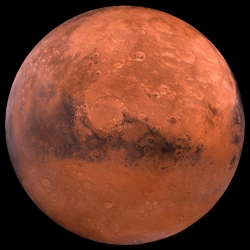
SpaceX president Gwynne Shotwell confirmed today that SpaceX is now targeting the year 2020 for the Mars trip, a move that will allow the company to better focus on its other ambitious projects. Spacex will focus more heavily on their crew program and their Falcon Heavy program.
Trips to Mars are best launched every 26 months, when the planet aligns with Earth on its orbit.
NASA’s next Mars rover is supposed to launch in 2020, as well as the rover for the ExoMars mission, a joint project between Roscosmos and the European Space Agency to look for signs of life on the planet. The United Arab Emirates plans to send an orbiter to Mars in 2020 as well, and even China has expressed a goal of reaching Mars by the end of the decade.
SpaceX is planning an unmanned mission to Mars using the Dragon V2 rocket, starting in 2020 and launch a rocket to Mars every 26 months. The plan is for the first manned Mars mission in 2024 or 2026.
The plan for 2020 is for a sample return Mars rover to be delivered to the Martian surface while also testing techniques to enter the Martian atmosphere with equipment a human crew could eventually use
NASA expects to spend "on the order of $30 million" helping SpaceX send the capsule to Mars.
A modified Dragon V2 capsule may perform all the necessary entry, descent and landing (EDL) functions in order to deliver payloads of 1 tonne (2,200 lb) or more to the Martian surface without using a parachute; the use of parachutes is not feasible without significant vehicle modifications.
It is calculated that the capsule’s own aerodynamic drag may slow it sufficiently for the remainder of descent to be within the capability of the SuperDraco retro-propulsion thrusters. 1900 kg of propellant would provide the Δv required for soft landing.
This approach should make it possible to land the capsule at much higher Martian elevations than could be done if a parachute was used, and with 10 km (6.2 mi) landing accuracy. The engineering team continues developing options for payload integration with the Dragon capsule. Potential landing sites would be polar or mid-latitude sites with proven near-surface ice.
A study of a potential 2021 Red Dragon mission suggested that it could offer a low-cost way for NASA to achieve a Mars sample return for study. The Red Dragon capsule would be equipped with the system needed to return samples gathered on Mars, including a Mars Ascent Vehicle (MAV), an Earth Return Vehicle (ERV), and hardware to transfer a sample collected in a previously landed rover mission, such as NASA’s planned Mars 2020 rover, to the ERV. ERV would transfer the samples to high Earth orbit, where a separate future mission would pick up the samples and de-orbit to Earth
There was a two page JPL proposal on a 2018 Mars Spacex mission. Red Dragon-MSL Hybrid Landing Architecture for 2018. M. R. Grover, E. Sklyanskiy , A. D. Steltzner , and B. Sherwood, Jet Propulsion Laboratory, California Institute of Technology
Hybridizing a variant of the SpaceX Dragon spacecraft (as a Mars lander) with a hypersonic guidance strategy based on the JPL MSL mission (Mars Science Laboratory), the proposed architecture opens a Pathway to commercially provided landing of heavy payloads on Mars with 10-km landing accuracy. The architecture relies on SpaceX SuperDraco engines for supersonic retropropulsion that would decelerate the Dragon-variant spacecraft from supersonic speed to a soft landing on the surface of Mars, thus demonstrating a keystone enabling technology for human exploration. Landed payloads (e.g., surface science packages) that could take advantage of this capability are open to further study by the science community based on Planetary Science Decadal Survey priorities.
Mission Architecture: A potential mission for the 2018 Mars opportunity would send a Dragon variant to Mars, supported by the SpaceX Dragon trunk module during cruise. The Dragon-variant spacecraft would perform a direct entry into the atmosphere at 6.0 km per second and utilize entry guidance during both hypersonic and supersonic phases of flight. Unlike MSL, the spacecraft would not deploy a parachute decelerator, but rather would transition directly from atmospheric flight to powered descent at Mach 2.24.
A high-thrust, powered descent phase would rapidly slow the vehicle to 2.4 meters per second 40 meters above the surface. From that height the vehicle would descend at a constant rate of 2.4 meters per second, performing a soft landing at the same velocity.
The Dragon-variant spacecraft would land on a legged subsystem as illustrated in SpaceX vehicle concepts.
The Spacex Falcon Heavy is need to launch the unmanned Mars mission. A Falcon Heavy could send 7200 kg on to Mars with significant
margin.
